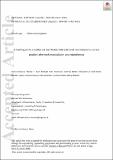A marking of the cricothyroid membrane with extended neck returns to correct position after neck manipulation and repositioning
Abstract
Background Emergency front of neck airway access by anaesthetists carries a high failure rate and it is recommended to identify the cricothyroid membrane before induction of anaesthesia in patients with a predicted difficult airway. We have investigated whether a marking of the cricothyroid membrane done in the extended neck position remains correct after the patient’s neck has been manipulated and subsequently repositioned Methods The subject was first placed in the extended head and neck position and had the cricothyroid membrane identified and marked with three methods, palpation, ‘laryngeal handshake’ and ultrasonography and the distance from the suprasternal notch to the cricothyroid membrane was measured. The subject then moved off the table and sat on a chair and subsequently returned to the extended neck position and examinations were repeated. Results Skin markings of all 11 subjects lay within the boundaries of the cricothyroid membrane when the subject was repositioned back to the extended neck position and the median difference between the two measurements of the distance from the suprasternal notch was 0 mm (range 0‐2 mm). Conclusion The cricothyroid membrane can be identified and marked with the subject in the extended neck position. Then the patient’s position can be changed as needed, for example to the ‘sniffing’ neck position for conventional intubation. If a front of neck airway access is required during subsequent airway management, the patient can be returned expediently to the extended‐neck position, and the marking of the centre of the membrane will still be in the correct place.
Citation
Bowness , J , Teoh , W H , Kristensen , M S , Dalton , A , Le Saint-Grant , A , Taylor , A , Crawley , S , Chisholm , F , Varsou , O & McGuire , B 2020 , ' A marking of the cricothyroid membrane with extended neck returns to correct position after neck manipulation and repositioning ' , Acta Anaesthesiologica Scandinavica , vol. 64 , no. 10 , pp. 1422-1425 . https://doi.org/10.1111/aas.13680
Publication
Acta Anaesthesiologica Scandinavica
Status
Peer reviewed
ISSN
0001-5172Type
Journal article
Collections
Items in the St Andrews Research Repository are protected by copyright, with all rights reserved, unless otherwise indicated.

